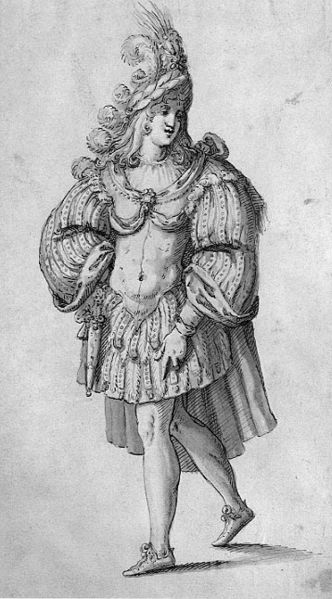The masque was a form of festive courtly entertainment that flourished in 16th- and early 17th-century Europe, though it was developed earlier in Italy, in forms including the intermedio. A masque involved music, dancing, singing and acting, within an elaborate stage design, in which the architectural framing and costumes might be designed by a renowned architect, to present a deferential allegory flattering to the patron. Professional actors and musicians were hired for the speaking and singing parts. Masquers who did not speak or sing were often courtiers: the English queen Anne of Denmark frequently danced with her ladies in masques between 1603 and 1611, and Henry VIII and Charles I of England performed in the masques at their courts. In the tradition of masque, Louis XIV of France danced in ballets at Versailles with music by Jean-Baptiste Lully.

Costume for a Knight, by Inigo Jones: the plumed helmet, the "heroic torso" in armour and other conventions were still employed for opera seria in the 18th century.
The intermedio, in the Italian Renaissance, was a theatrical performance or spectacle with music and often dance, which was performed between the acts of a play to celebrate special occasions in Italian courts. It was one of the important precursors to opera, and an influence on other forms like the English court masque. Weddings in ruling families and similar state occasions were the usual occasion for the most lavish intermedi, in cities such as Florence and Ferrara. Some of the best documentation of intermedi comes from weddings of the House of Medici, in particular the 1589 Medici wedding, which featured what was undoubtedly both the most spectacular set of intermedi, and the best known, thanks to no fewer than 18 contemporary published festival books and sets of prints that were financed by the Grand Duke.
Setting designed by Bernardo Buontalenti for the third intermedio from the 1589 Medici wedding: Apollo defeats the monster terrorizing Delos.
Another of the 1589 intermedi: number 4: the demons lament that with the coming of the Golden Age there will be no more souls to torment.
Another of the 1589 intermedi; 6th intermedio: Apollo and Bacchus descend, accompanied by Harmony, Rhythm, the Three Graces, Flora and others.
Another of the 1589 intermedi: number 1: Harmony descends to earth





